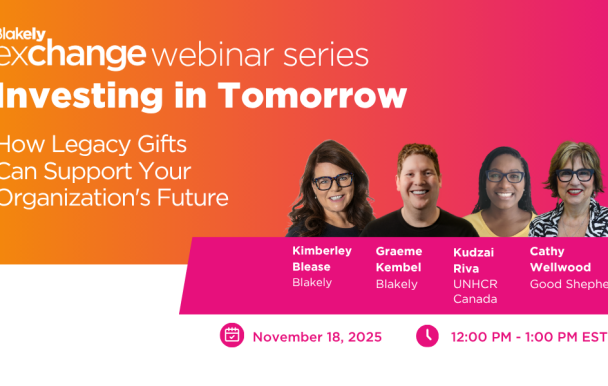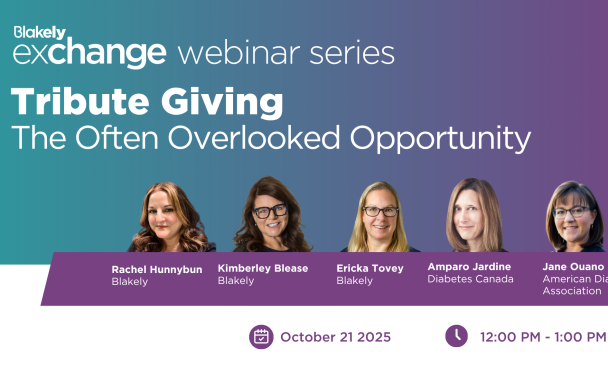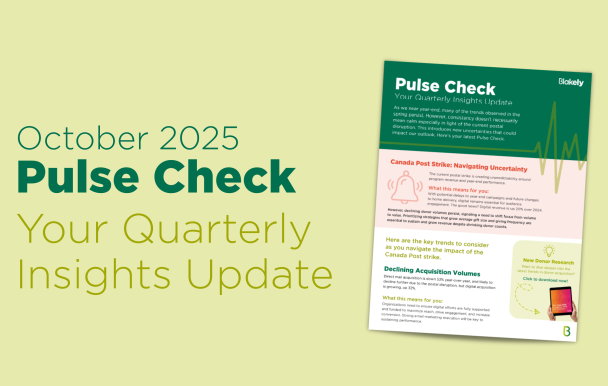Top 12 Insights From 12 Weeks of Webinars
In case you missed it, the Blakely team – led by Kimberley Blease and Rachel Hunnybun – has just recently completed a marathon 12-week webinar series, exploring many different fundraising topics in the current COVID-19 context.
Like every industry globally, the charitable sector has been impacted by the coronavirus pandemic, and we’ve been forced to adapt the way we do our work over the past number of months. Now, with twelve webinars under our belts, compounded by daily experience in our work with our clients, we wanted to reflect on some of our biggest insights.
#1: Stop / start / continue
In those early days when the coronavirus became a real threat, at least here in North America, a framework that helped us – as an agency, and with our clients – was “stop / start / continue.”
This exercise is particularly helpful as it relates to fundraising channels. Certain channels for fundraising have been completely off the table (i.e. face-to-face, events), other channels are still viable (direct mail, telemarketing), and other channels needed to be ramped up (emails, digital).
As the fundraising landscape continues to change, it’s important to take stock of where you are, where you want to go, and what you’ll do to get there. Consider using stop / start / continue to help you plan.
#2: Consider our organization’s role in the pandemic
All charities have a role to play right now, but considering where you sit as it relates to COVID-19, can help inform the audiences you should be reaching out to, as well as your key messaging, content, and tactics.
- Emergency Frontline Response – Organizations delivering frontline response directly linked to COVID-19
- Direct Community Support – Organizations offering services at the community level, with need increasing or work more challenging as a result of COVID-19
- End Goal Solutions – Organizations working towards treatments/vaccines
- Direct Beneficiary Support – Organizations supporting a group made more vulnerable by COVID-19 (from a financial or health perspective)
- Donor Support – Organizations with no direct role in COVID-19 response, but with a donor base to keep communicating with
#3: Positive attitudes towards charitable giving
In partnership with The Aber Group, we have conducted two surveys on attitudes towards charitable giving (first in late March, then in late May), and overwhelmingly, the attitudes have been positive.
First, people support charities in continuing to fundraise during this time. People are particularly positive towards those organizations responding to the pandemic, but there was a strong intent to maintain or increase charitable giving to their favourite charities, regardless of role. These insights helped us make the case for continued donor engagement and fundraising throughout this time.
#4: Necessity is the mother of invention
Christina Topp, VP Community Engagement at Sunnybrook Foundation, joined us for our fourth webinar on Integration. Sunnybrook has been at the global forefront of the pandemic since the first Canadian case was identified, so Christina walked us through what this meant for the Foundation team, in communicating to donors and the greater community.
The biggest impact was that it forced the team to collaborate, unite around shared goals, communicate with a more singular voice, and respond more quickly to opportunities. They did this through regular, integrated meetings, shared priority-setting, clear expectations, weekly calendar reviews, and transparent communication including reporting back on results.
If it took a pandemic for your organization to collaborate, congratulations on getting there! It will benefit you now and into the future.
#5: Be human
Blakely has been all about the donor experience for a while now, but in 2020 we believe it’s critical. In the for-profit world, customer experience now accounts for 50% of all purchasing decisions; it matters to people even more than the product or price. And a pandemic is not a time to shift attention away from donor experience; instead, in a time where we feel uncertain, anxious, and out of control, charities can create a real connection with us. This can be done by communicating from human to human and being authentic, transparent, and even vulnerable.
#6: Permission = Granted
Permission to Fail, Permission to Test, Permission to Do New Things = Granted
Webinar #7 – “Recovery Starts Now” – was all about how to plan for recovery and shape future success. This was one of my favourite lessons in the webinars, because I really believe that in order to learn and grow and be positioned for success during and after the pandemic, we need to remove barriers. And one of the biggest barriers we put in front of ourselves are reasons not to do things differently. Now more than ever we need to remove these obstacles. So, give yourself permission. Your organization will thank you later.
#7: Conversations in Legacy
Like every area of fundraising right now, Legacy Giving is transforming. We have been advocating for a change in legacy fundraising for a while now, but as with everything we’ve been discussing, the time to reform and reframe is now.
One transformation to consider: Measuring differently. Legacy program success continues to hinge on “confirmations” (i.e., a signed form confirming a donor’s intent to leave the organization in their will). Yet, we know that many legacy gifts come from donors you didn’t know were planning to assign a gift, or even people you don’t know at all! These gifts often come from years of annual giving touchpoints or broad-based marketing, so consider how you can shift your measurement to be more about engagement and conversations, and how that predicts legacy long-term.
#8: The three whys
The fundraising proposition or “3 whys” is the root of every good solicitation, and so when we talked about monthly giving in our May 19th webinar, we focused on the whys.
Why give monthly? Why does giving monthly matter now? Why should you give monthly to [Insert Charity’s Name Here]? Survey results are showing some warmth to monthly giving – especially by the donors already giving to you. So put your best case forward in your monthly conversion tactics.
#9: Bridge to ongoing support
On May 26th we conducted a webinar focused mostly on those charities who are directly responding to the COVID-19 crisis, like hospitals and food banks, and the huge numbers of new donors they’ve acquired over the past few months.
These new donors don’t necessarily behave like new donors from six months ago; they gave in response to a pandemic – a very specific and urgent situation – so how do we motivate these donors to continue giving now and in the future? The most critical piece is to build a bridge from their initial motivation to a deeper, ongoing connection to your organization. Consider this bridge in your strategies and messages, and you’ll drive the strongest second-gift rate you can.
#10: Donor needs & COVID-19
The results from our second survey on attitudes towards charitable giving confirmed two critical insights behind giving in a pandemic. First, it validated that a common donor need – combatting helplessness – was very much at play here. We have less control over our surroundings in this pandemic, and so a way to take action and feel more in control is to give.
The more emotional expression of that is, that the global experience of this pandemic has increased our empathy. On the one hand, in this moment humanity feels more connected than ever. On the other hand, COVID-19 – combined with the increased spotlight on systemic racism and police violence in the US – has further exposed the inequality in our world. This “reckoning” so to speak, drives us to action, and we express our values and what matters to us through giving.
#11: The result of cutting touchpoints
All charitable organizations had to take a hard look at their budgets over the course of the last four months. Some simply had to shift budgets, while other charities had to let go of significant numbers of staff. Re-budgeting/re-projecting was an unfortunate reality for everybody, but when it came to planned fundraising touchpoints, there were those who slashed activities, and those who stuck with what they planned – or even did more.
What are the results between those two camps? As of mid-June, we’re seeing the results below, across a number of our clients. What did we learn? Keep fundraising.
| Growth YOY | Some / Many Fewer Touchpoints | Maintained / Increased Touchpoints |
| New Donors | 1.0% | 1220% |
| Renewal Rate | 3.4% | 7.0% |
| Reactivation Rate | 3.0% | 35.0% |
| Average Gift | $2.34 | $16.64 |
| Mid-Level Gifts | 37% | 433% |
| Upgraded Gifts | 2.7% | 70% |
#12: Digital Infrastructure
Our final webinar (for now) was on June 16th and focused again on digital. If there’s one thing we’ve learned during this unprecedented time, it’s the importance of digital fundraising. Our ways of interacting, communicating and purchasing have changed dramatically, and everything is increasingly digital. I thought life was already pretty digital, but I’ve been in front of screens more since March than I was before, and even as a millennial, I’ve become more comfortable making more transactions online.
An existing shift progressed at lightning speed, and not all charities were ready, so if you haven’t yet: consider your digital infrastructure. If you’re new to this, start with the basics: make sure your donation forms are functioning and that you’re using Google Grants. If you’d call yourself intermediate, you might want to think about marketing automation, email audience segmentation, and more robust tracking and reporting. If you’re a pro, there’s still more to do: consider how you can make real-time data integration between systems a possibility, or audit your “cart abandonment” / remarketing journeys.
If I’ve learned anything since mid-March – and with 12 webinars of insights – it’s that knowledge and expertise are only part of doing great fundraising. The attitudes you bring to your work – openness, skepticism, transparency, collaboration, passion, agility… the list goes on – help you survive and thrive.
For those of you who joined us for one or all of the webinars – thank you. To everyone – stay tuned for more in the Fall!









